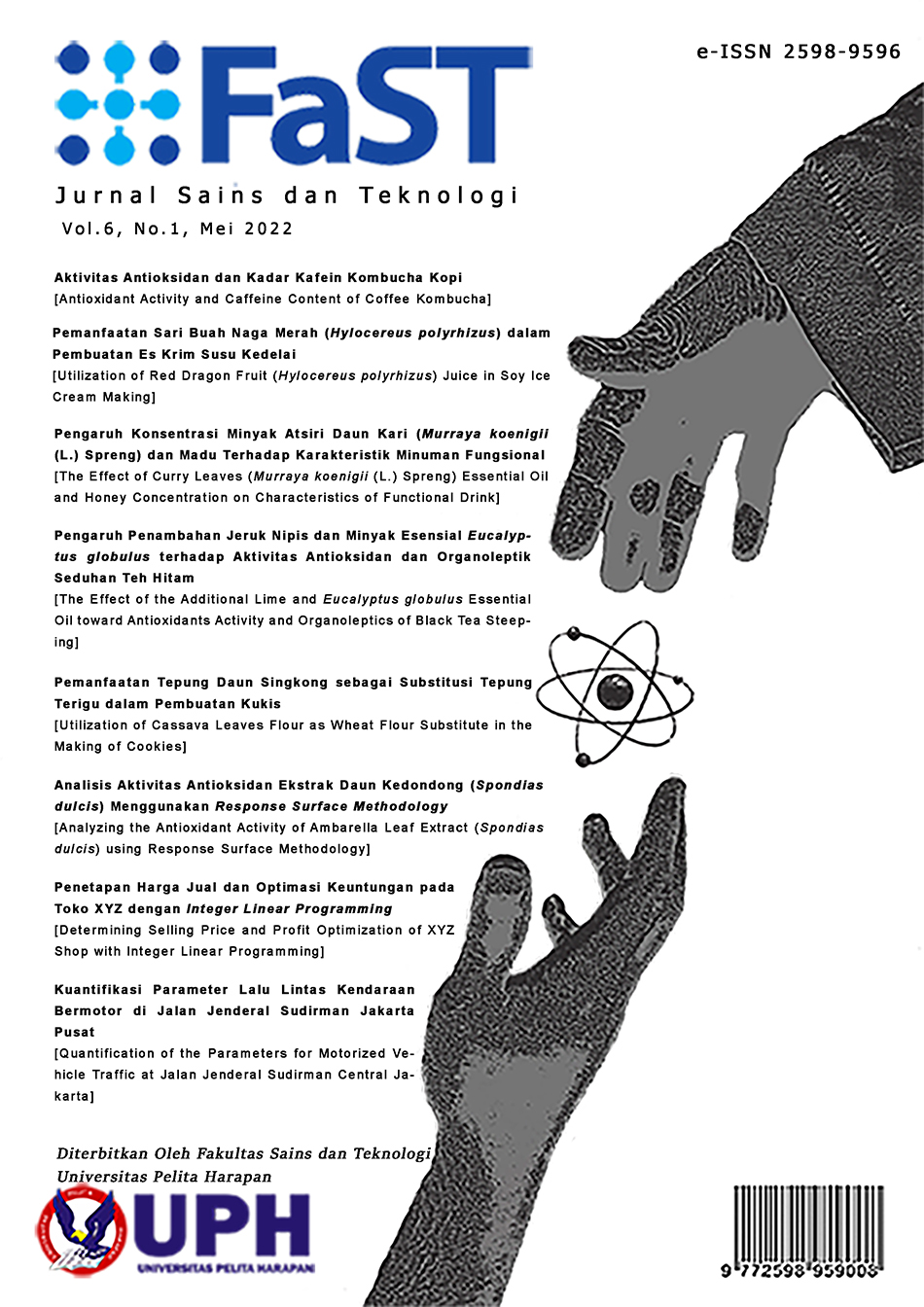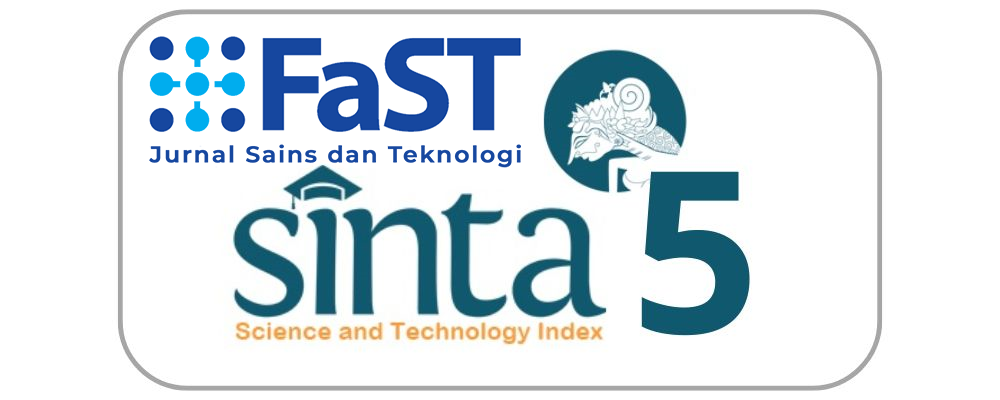Aktivitas Antioksidan dan Kadar Kafein Kombucha Kopi [Antioxidant Activity and Caffeine Content of Coffee Kombucha]
DOI:
https://doi.org/10.19166/jstfast.v6i1.4740Keywords:
antioxidant, caffeine, coffee, kombuchaAbstract
Kombucha is the result of the fermentation of tea and sugar by a kombucha culture starter known as SCOBY (Symbiosis Culture of Bacteria and Yeast). One of the efforts that possible to improve the functional aspects of coffee is by the fermentation process of kombucha. Based on that hypothesis, the goal of this research is to develop the potential of coffee through kombucha fermentation. This research involves two stages that include stage I research with type of coffee (arabica, robusta, liberica) and fermentation time (0, 3, 6, 9 days) as the factors, and stage II research performed on coffee kombucha with selected types of coffee. In stage I research, analysis of antioxidant activity was performed to determine the treatment that produced coffee kombucha with the highest antioxidant activity, supported by analysis of total lactic acid bacteria, total yeast, and pH value. In stage II research, analysis of caffeine content was performed to determine the best fermentation time that produces coffee kombucha with the highest caffeine content. Another supporting analysis carried out in this research is water content analysis of coffee grounds and the identification of microbes in the liquid kombucha starter. The treatment that can produce coffee kombucha with the highest antioxidant activity is arabica coffee with an average IC50 value of 4689,41 ppm and 9 days of fermentation with an average IC50 value of 4988,90 ppm. Analysis of caffeine content carried out on arabica coffee kombucha showed an increment in caffeine content during the fermentation process, as the highest caffeine content is 0,77% on the 9th day of fermentation.
BAHASA INDONESIA ABSTRACT:
Kombucha merupakan hasil fermentasi teh dan gula oleh starter kultur kombucha yang disebut sebagai SCOBY (Symbiosis Culture of Bacteria and Yeast). Salah satu upaya yang dapat dilakukan untuk meningkatkan aspek fungsional kopi adalah dengan proses fermentasi kombucha. Berdasarkan hipotesis tersebut penelitian ini dilaksanakan guna mengembangkan potensi kopi lewat fermentasi kombucha. Penelitian ini terbagi menjadi 2 tahap yang meliputi penelitian tahap I dengan faktor jenis kopi (arabika, robusta, liberika) dan lama fermentasi (0, 3, 6, 9 hari) serta penelitian tahap II yang dilakukan pada kombucha kopi dengan jenis kopi terpilih. Analisis aktivitas antioksidan dilakukan pada tahap I untuk menentukan perlakuan yang menghasilkan kombucha kopi dengan aktivitas antioksidan tertinggi, didukung dengan analisis total bakteri asam laktat, total khamir, dan nilai pH. Pada tahap II, dilakukan analisis kadar kafein untuk menentukan lama fermentasi terbaik yang menghasilkan kombucha kopi dengan kadar kafein tertinggi. Analisis pendukung lain yang dilakukan adalah analisis kadar air bubuk kopi dan identifikasi mikroba pada starter kombucha cair. Perlakuan yang dapat menghasilkan kombucha kopi dengan aktivitas antioksidan tertinggi adalah jenis kopi arabika dengan nilai IC50 rata-rata sebesar 4689,41 ppm dan lama fermentasi 9 hari dengan nilai IC50 rata-rata sebesar 4988,90 ppm. Analisis kadar kafein dilakukan pada kombucha kopi arabika menunjukkan terjadinya peningkatan kadar kafein selama proses fermentasi dengan kadar tertinggi pada fermentasi hari ke-9 yaitu 0,77%.
References
Association of Official Analytical Chemist (AOAC). (2005). Official methods of analysis of the association analytical chemists. AOAC International.
Association of Official Analytical Chemist (AOAC). (2012). Estimation of antioxidant activity in foods and beverages by reaction with 2,2”²- diphenyl-1-picrylhydrazyl (DPPH). AOAC International.
Atma, Y. (2016). Angka lempeng total (ALT), angka paling mungkin (APM) dan total kapang khamir sebagai metode analisis sederhana untuk menentukan standar mikrobiologi pangan olahan posdaya. Jurnal Teknologi, 8(2), 77-82. https://doi.org/10.24853/jurtek.8.2.77-83
Badan Standarisasi Nasional (BSN). (2009). Minuman susu fermentasi Berperisa. SNI 7552:2009. Badan Standarisasi Nasional.
Bjarnadottir, A. (2019). Coffee and antioxidants: everything you need to know. Retrieved July 14, 2019, from https://www.healthline.com/nutrition/coffee-worlds-biggest-source-of-antioxidants
Chakravorty, S., Bhattacharya, S., Chatzinotas, A., Chakraborty, W., Bhattacharya, D., & Gachhui, R. (2016). Kombucha tea fermentation: microbial and biochemical dynamics. International Journal of Food Microbiology, 220, 63-72. https://doi.org/10.1016/j.ijfoodmicro.2015.12.015
Codex Alimentarius Commission (Codex). (2018). Codex standard for fermented milks (Rev. ed). Codex Alimentarius Commission.
Coton, M., Pawtowski, A., Taminuau, B., Buragud, G., Deniel, F., Labarthe, L. C., Fall, A., Daube, G., & Coton, E. (2017). Unraveling microbial ecology of industrial-scale kombucha fermentation by metabarcoding and culture-based methods. FEMS Microbiology Ecology, 93(5), 1-16. https://doi.org/10.1093/femsec/fix048
Essawet, N. A., Cvetkovic, D., Velicanski, A., Brunet, J. C., Vulic, J., Maksimovic, V., & Sinisa, M. (2015). Polyphenols and antioxidant activities of kombucha beverage enriched with coffeeberry extract. Chemical Industry and Chemical Engineering Quarterly, 21(3), 399-409. https://doi.org/10.2298/CICEQ140528042E
Falahuddin, I., Apriani, I., & Nurfadilah. (2017). Pengaruh proses fermentasi kombucha daun sirsak (Annona Muricata L.) terhadap kadar vitamin c. Biota, 3(2), 90. https://doi.org/10.19109/biota.v3i2.1323
Food and Drug Administration (FDA). (2009). Food code. Food and Drug Administration.
International Coffee Organization (ICO). (2020). Historical data on the global coffee trade. Statistics. Retrieved from http://www.ico.org/new_historical.asp?section=Statistics
Jayabalan, R., Malbasa, R. V., Loncar, E. S., Vitas, J. S., & Sathishkumar, M. (2014). A review on kombucha tea- microbiology, composition, fermentation, beneficial effects, toxicity, and tea fungus. Comprehensive Reviews in Food Science and Food Safety, 13(4), 538-550. https://doi.org/10.1111/1541-4337.12073
Jin, L., Bhuiya, M. W., Li, M., Liu, X., Han, J., Deng, W., Wang, M., Yu, O., & Zhang, Z. (2014). Metabolic engineering of Saccharomyces cerevisiae for caffeine and theobromine production. PLoS ONE, 9(8), e105368. https://doi.org/10.1371/journal.pone.0105368
Kombucha Brewers International (KBI). 2020. Kombucha code of practice (2nd ed). Retrieved from https://kombuchabrewers.org/kombucha-code-of-practice/
Laureys, D., Britton, S. J., & Clippeleer, J. D. (2020). Kombucha tea fermentation: a review. Journal of the American Society of Brewing Chemist, 78(3), 165-174. https://doi.org/10.1080/03610470.2020.1734150
McKeague, M., Wang, Y. H., Cravens, A., Win, M. N., & Smolke, C. D. (2016). Engineering a microbial platform for de novo biosynthesis of diverse methylxanthines. Metabolic Engineering, 38, 191-203. https://doi.org/10.1016/j.ymben.2016.08.003
Morales, D. (2020). Biological Activities of Kombucha beverages: the need of clinical evidence. Trends in Food Science & Technology, 105, 323-333. https://doi.org/10.1016/j.tifs.2020.09.025
Pérez-Jiménez, J., Neveu, V., Vos, F., & Scalbert, A. (2010). Identification of the 100 richest dietary sources of polyphenols: an application of the Phenol-Explorer database. European Journal of Clinical Nutrition, 64, S112- S120. https://doi.org/10.1038/ejcn.2010.221
Specialty Coffee Association (SCA). (2018). Coffee standards. Specialty Coffee Association.
Suhardini, P. N., & Zubaidah, E. N. (2016). Studi aktivitas antioksidan kombucha dari berbagai jenis daun selama fermentasi. Jurnal Pangan dan Agroindustri, 4(1), 221-229.
Villarreal-soto, S. A., Beaufort, S., Bouajila, J., Souchard, J. P., & Taillandier, P. (2018). Understanding kombucha tea fermentation: a review. Journal of Food Science, 83(3), 580-588. https://doi.org/10.1111/1750-3841.14068
Watawana, M. I., Jayawardena, N., & Waisundara, V. Y. (2015). Enhancement of the functional properties of coffee through fermentation by “tea fungus” (kombucha). Journal of Food Processing and Preservation, 39(6), 2596-2603. https://doi.org/10.1111/jfpp.12509
Widodo, T.S., Sulistiyanto, B., & Utama, C.S. (2015). Jumlah bakteri asam laktat (bal) dalam digesta usus halus dan sekum ayam broiler dan diberi pakan ceceran pabrik pakan yang difermentasi. Agripet, 15(2), 98-103. https://doi.org/10.17969/agripet.v15i2.2376
Downloads
Published
Issue
Section
License
“Authors who publish with this journal agree to the following terms:
1) Authors retain copyright and grant the journal right of first publication with the work simultaneously licensed under a Creative Commons Attribution License (CC-BY-SA 4.0) that allows others to share the work with an acknowledgement of the work's authorship and initial publication in this journal.
2) Authors are able to enter into separate, additional contractual arrangements for the non-exclusive distribution of the journal's published version of the work (e.g., post it to an institutional repository or publish it in a book), with an acknowledgement of its initial publication in this journal.
3) Authors are permitted and encouraged to post their work online (e.g., in institutional repositories or on their website). The final published PDF should be used and bibliographic details that credit the publication in this journal should be included.”



